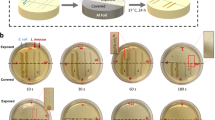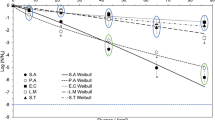Abstract
Microbial food spoilage is an important cause of health and economic issues and can occur via resilient contamination of food surfaces. Novel technologies, such as the use of visible light, have seen the light of day to overcome the drawbacks associated with surface disinfection treatments. However, most studies report that photo-inactivation of microorganisms with visible light requires long time treatments. In the present study, a novel light electroluminescent diode (LED)-based device was designed to generate irradiation at an ultra-high power density (901.1 mW/cm2). The efficacy of this technology was investigated with the inactivation of the yeast S. cerevisiae. Short-time treatments (below 10 min) at 405 nm induced a ~4.5 log reduction rate of the cultivable yeast population. The rate of inactivation was positively correlated to the overall energy received by the sample and, at a similar energy, to the power density dispatched by the lamp. A successful disinfection of several food contact surfaces (stainless steel, glass, polypropylene, polyethylene) was achieved as S. cerevisiae was completely inactivated within 5 min of treatments. The disinfection of stainless steel was particularly effective with a complete inactivation of the yeast after 2 min of treatment. This ultra-high irradiance technology could represent a novel cost- and time-effective candidate for microbial inactivation of food surfaces. These treatments could see applications beyond the food industry, in segments such as healthcare or public transport.
Key points
• A novel LED-based device was designed to emit ultra-high irradiance blue light
• Short time treatments induced high rate of inhibition of S. cerevisiae
• Multiple food contact surfaces were entirely disinfected with 5-min treatments





Similar content being viewed by others
Data availability
The datasets generated during and/or analyzed during the current study are available from the corresponding author on reasonable request.
References
Böcking T, Barrow KD, Netting AG, Chilcott TC, Coster HGL, Höfer M (2000) Effects of singlet oxygen on membrane sterols in the yeast Saccharomyces cerevisiae. Eur J Biochem 267:1607–1618. https://doi.org/10.1046/j.1432-1327.2000.01179.x
Bohm GC, Gándara L, Di Venosa G, Mamone L, Buzzola F, Casas A (2020) Photodynamic inactivation mediated by 5-aminolevulinic acid of bacteria in planktonic and biofilm forms. Biochem Pharmacol 177:114016. https://doi.org/10.1016/j.bcp.2020.114016
Buchovec I, Paskeviciute E, Luksiene Z (2010) Photodynamic Inactivation of Food Pathogen Listeria monocytogenes. Food Technol Biotechnol 48:207–213
Bumah VV, Masson-Meyers DS, Cashin SE, Enwemeka CS (2013) Wavelength and bacterial density influence the bactericidal effect of blue light on methicillin-resistant Staphylococcus aureus (MRSA). Photomed Laser Surg 31:547–553. https://doi.org/10.1089/pho.2012.3461
Cabral J, Rodrigues A (2019) Blue Light Disinfection in Hospital Infection Control : Advantages, Drawbacks, and Pitfalls. Antibiotics 8:1–21
Calderhead RG (2017) Photobiological Basics of Photomedicine: A Work of Art Still in Progress. Med Lasers 6:45–57. https://doi.org/10.25289/ml.2017.6.2.45
Cieplik F, Tabenski L, Buchalla W, Maisch T (2014) Antimicrobial photodynamic therapy for inactivation of biofilms formed by oral key pathogens. Front Microbiol 5:1–17. https://doi.org/10.3389/fmicb.2014.00405
Cieplik F, Pummer A, Regensburger J, Hiller KA, Späth A, Tabenski L, Buchalla W, Maisch T (2015) The impact of absorbed photons on antimicrobial photodynamic efficacy. Front Microbiol 6:706. https://doi.org/10.3389/fmicb.2015.00706
Dupont S, Rapoport A, Gervais P, Beney L (2014) Survival kit of Saccharomyces cerevisiae for anhydrobiosis. Appl Microbiol Biotechnol 98:8821–8834. https://doi.org/10.1007/s00253-014-6028-5
Endarko E, Maclean M, Timoshkin I V., MacGregor SJ, Anderson JG (2012) High-intensity 405 nm light inactivation of Listeria monocytogenes. In: Photochemistry and Photobiology. pp 1280–1286
Enwemeka CS, Baker TL, Bumah VV (2021) The role of UV and blue light in photo-eradication of microorganisms. J Photochem Photobiol 8:100064. https://doi.org/10.1016/j.jpap.2021.100064
Ferreira LR, Sousa AS, Alvarenga LH, Deana AM, Onofre Simões de Santa MEO, Kato IT, Leal CRL, Ribeiro MS, Prates RA (2016) Photodiagnosis and Photodynamic Therapy Antimicrobial photodynamic therapy on Candida albicans pre-treated by fluconazole delayed yeast inactivation. Photodiagn Photodyn Ther 15:25–27. https://doi.org/10.1016/j.pdpdt.2016.05.002
Gayán E, García-Gonzalo D, Álvarez I, Condón S (2014) Resistance of Staphylococcus aureus to UV-C light and combined UV-heat treatments at mild temperatures. Int J Food Microbiol 172:30–39. https://doi.org/10.1016/j.ijfoodmicro.2013.12.003
Ghate VS, Zhou W, Yuk HG (2019) Perspectives and Trends in the Application of Photodynamic Inactivation for Microbiological Food Safety. Compr Rev Food Sci Food Saf 18:402–424. https://doi.org/10.1111/1541-4337.12418
Gillespie JB, Maclean M, Given MJ, Wilson MP, Judd MD, Timoshkin IV, Macgregor SJ (2017) Efficacy of Pulsed 405-nm Light-Emitting Diodes for Antimicrobial Photodynamic Inactivation: Effects of Intensity, Frequency, and Duty Cycle. Photomed Laser Surg 35:150–156. https://doi.org/10.1089/pho.2016.4179
Grangeteau C, Lepinois F, Winckler P, Perrier-Cornet JM, Dupont S, Beney L (2018) Cell death mechanisms induced by photo-oxidation studied at the cell scale in the yeast Saccharomyces cerevisiae. Front Microbiol 9:1–8. https://doi.org/10.3389/fmicb.2018.02640
Guerrero-Beltrán JA, Barbosa-Cánovas GV (2004) Review: Advantages and limitations on processing foods by UV light. Food Sci Technol Int 10:137–147. https://doi.org/10.1177/1082013204044359
Gunther NW, Phillips JG, Sommers C (2016) The Effects of 405-nm Visible Light on the Survival of Campylobacter on Chicken Skin and Stainless Steel. Foodborne Pathog Dis XX:1–6. https://doi.org/10.1089/fpd.2015.2084
Haitz’ s law. (2007). Nature Photonics, 1(23). https://doi.org/10.1038/nphoton.2006.78
Hessling M, Spellerberg B, Hoenes K (2017) Photoinactivation of bacteria by endogenous photosensitizers and exposure to visible light of different wavelengths - A review on existing data. FEMS Microbiol Lett 364:1–12. https://doi.org/10.1093/femsle/fnw270
Hoenes K, Hess M, Vatter P, Spellerberg B, Hessling M (2018) 405 nm and 450 nm photoinactivation of Saccharomyces cerevisiae. Eur J Microbiol Immunol 8:142–148. https://doi.org/10.1556/1886.2018.00023
Hsieh CM, Huang YH, Chen CP, Hsieh BC, Tsai T (2014) 5-Aminolevulinic acid induced photodynamic inactivation on Staphylococcus aureus and Pseudomonas aeruginosa. J Food Drug Anal 22:350–355. https://doi.org/10.1016/j.jfda.2013.09.051
Hu X, Huang YY, Wang Y, Wang X, Hamblin MR (2018) Antimicrobial photodynamic therapy to control clinically relevant biofilm infections. Front Microbiol 9:1–24. https://doi.org/10.3389/fmicb.2018.01299
Kercher EM, Zhang K, Waguespack M, Lang RT, Olmos A, Spring BQ (2020) High-power light-emitting diode array design and assembly for practical photodynamic therapy research. J Biomed Opt 25:1. https://doi.org/10.1117/1.jbo.25.6.063811
Lui GY, Roser D, Corkish R, Ashbolt NJ, Stuetz R (2016) Point-of-use water disinfection using ultraviolet and visible light-emitting diodes. Sci Total Environ 553:626–635. https://doi.org/10.1016/j.scitotenv.2016.02.039
Mckenzie K, Maclean M, Timoshkin IV, Endarko E, Macgregor SJ, Anderson JG (2013) Photoinactivation of Bacteria Attached to Glass and Acrylic Surfaces by 405 nm Light : Potential Application for Biofilm Decontamination. Photochem Photobiol 89:927–935. https://doi.org/10.1111/php.12077
Murdoch LE, McKenzie K, Maclean M, MacGregor SJ, Anderson JG (2013) Lethal effects of high-intensity violet 405-nm light on Saccharomyces cerevisiae, Candida albicans, and on dormant and germinating spores of Aspergillus niger. Fungal Biol 117:519–527. https://doi.org/10.1016/j.funbio.2013.05.004
Ogonowska P, Woźniak A, Pierański MK, Wasylew T, Kwiek P, Brasel M, Grinholc M, Nakonieczna J (2019) Application and characterization of light-emitting diodes for photodynamic inactivation of bacteria. Light Res Technol 51:612–624. https://doi.org/10.1177/1477153518781478
Prasad A, Gänzle M, Roopesh MS (2019) Inactivation of Escherichia coli and Salmonella using 365 and 395 nm high intensity pulsed light emitting diodes. Foods 8:679. https://doi.org/10.3390/foods8120679
Prates RA, da Silva EG, Yamada AM Jr, Suzuki LC, Paula CR, Ribeiro MS (2008) The irradiation parameters investigation of photodynamic therapy on yeast cells. Mech Low-Light Ther III 6846:684606. https://doi.org/10.1117/12.763059
Qin Y, Luan X, Bi L, He G, Bai X, Zhou C, Zhang Z (2008) Toluidine blue-mediated photoinactivation of periodontal pathogens from supragingival plaques. In: Lasers in Medical Science. pp 49–54
Rapoport A, Golovina EA, Gervais P, Dupont S, Beney L (2019) Anhydrobiosis: Inside yeast cells. Biotechnol Adv 37:51–67. https://doi.org/10.1016/j.biotechadv.2018.11.003
Schlegelová J, Babák V, Holasová M (2010) Microbial Contamination after Sanitation of Food Contact Surfaces in Dairy and Meat Processing Plants. Czech J Food Sci 28:450–461
Shehatou C, Logunov SL, Dunman PM, Haidaris CG, Klubben WS (2019) Characterizing the Antimicrobial Properties of 405 nm Light and the Corning® Light-Diffusing Fiber Delivery System. Lasers Surg Med 51:887–896. https://doi.org/10.1002/lsm.23132
Shikano A, Kuda T, Takahashi H, Kimura B (2017) Effect of quantity of food residues on resistance to desiccation , disinfectants , and UV-C irradiation of spoilage yeasts adhered to a stainless steel surface. LWT Food Sci Technol 80:169–177. https://doi.org/10.1016/j.lwt.2017.02.020
Skåra T, Rosnes JT (2016) 6 - Emerging Methods and Principles in Food Contact Surface Decontamination/Prevention. Elsevier Ltd
Sousa V, Gomes ATPC, Freitas A, Faustino MAF, Neves MGPMS, Almeida A (2019) Photodynamic inactivation of candida albicans in blood plasma and whole blood. Antibiotics 8:221. https://doi.org/10.3390/antibiotics8040221
Taraszkiewicz A, Fila G, Grinholc M, Nakonieczna J (2013) Innovative strategies to overcome biofilm resistance. Biomed Res Int 2013:150653. https://doi.org/10.1155/2013/150653
Thery T, Lynch KM, Arendt EK (2019) Natural Antifungal Peptides / Proteins as Model for Novel Food Preservatives. Compr Rev Food Sci Food Saf 18:1327–1360. https://doi.org/10.1111/1541-4337.12480
Umeda M, Tsuno A, Okagami Y, Tsuchiya F, Izumi Y, Ishikawa I (2011) Bactericidal effects of a high-power, red light-emitting diode on two periodontopathic bacteria in antimicrobial photodynamic therapy in vitro. J Investig Clin Dent 2:268–274. https://doi.org/10.1111/j.2041-1626.2011.00071.x
Wallace-salinas V, Gorwa-grauslund MF (2013) Adaptive evolution of an industrial strain of Saccharomyces cerevisiae for combined tolerance to inhibitors and temperature. 1–9
Yoshino F, Yoshida A (2018) Effects of blue-light irradiation during dental treatment. Jpn Dent Sci Rev 54:160–168. https://doi.org/10.1016/j.jdsr.2018.06.002
Acknowledgements
This project was financially supported by AgroSup Dijon of Université de Bourgogne Franche-Comté, SATT SAYENS (Dijon, France), the European Regional Development Fund (FEDER Alim+) and the National Agency for Research (with GreenDeconta Project ANR18-CE21-0004-01).
Funding
This work was funded by AgroSup Dijon of Université de Bourgogne Franche-Comté, SATT SAYENS (Dijon, France), the European Regional Development Fund (FEDER Alim+) and the National Agency for Research (Grant Number GreenDeconta Project ANR18-CE21-0004-01). The funders had no involvement in study design, data collection, analysis and interpretation.
Author information
Authors and Affiliations
Contributions
LB, SD, and CG conceived and designed research. EL and JA performed experiments. CP developed the mathematical tools. CG, SD, and FC conceived and designed the prototype. EL and TT analyzed data and wrote the manuscript. LB, SD, and CG edited the manuscript. LB and SD supervised the research. All authors read and approved the manuscript.
Corresponding authors
Ethics declarations
Ethics approval
This article does not contain any studies with human participants or animals performed by any of the authors.
Conflict of interest
The authors declare no competing interests.
Additional information
Publisher’s note
Springer Nature remains neutral with regard to jurisdictional claims in published maps and institutional affiliations.
Supplementary information
ESM 1
(PDF 181 kb)
Rights and permissions
About this article
Cite this article
Lang, E., Thery, T., Peltier, C. et al. Ultra-high irradiance (UHI) blue light: highlighting the potential of a novel LED-based device for short antifungal treatments of food contact surfaces. Appl Microbiol Biotechnol 106, 415–424 (2022). https://doi.org/10.1007/s00253-021-11718-9
Received:
Revised:
Accepted:
Published:
Issue Date:
DOI: https://doi.org/10.1007/s00253-021-11718-9




